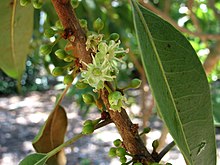Bidens molokaiensis, the Molokaʻi beggarticks, is a species of flowering plant in the family Asteraceae. It belongs to the genus Bidens, collectively called kokoʻolau or koʻokoʻolau in the Hawaiian language. It is found only on Molokaʻi in the Hawaiian Islands.
Aubregrinia is a genus of plant in the family Sapotaceae first described as a genus in 1935.
Neohemsleya is a genus of plant in family Sapotaceae described as a genus in 1991.
Sideroxylon nadeaudii is a species of plant in the family Sapotaceae. It is endemic to Tahiti, French Polynesia.
Sideroxylon st-johnianum is a species of plant in the family Sapotaceae. It is endemic to Henderson Island, Pitcairn. Having been described first as Nesoluma st-johnianum (1938), this species was transferred to the genus Sideroxylon in 2007 as a result of the phylogenetic analyses.
Sideroxylon acunae is a species of plant in the family Sapotaceae. It is endemic to Cuba.
Sideroxylon anomalum is a species of plant in the family Sapotaceae. It is endemic to the Dominican Republic.
Sideroxylon bullatum is a species of plant in the family Sapotaceae. It is endemic to Jamaica. It is threatened by habitat loss.
Sideroxylon cartilagineum is a species of plant in the family Sapotaceae. It is endemic to Mexico.
Sideroxylon cubense is a species of plant in the family Sapotaceae. It is native to Cuba, the Dominican Republic, Haiti, the Leeward Islands, and Puerto Rico.
Sideroxylon contrerasii is a species of plant in the family Sapotaceae. It is found in Costa Rica, Guatemala, Mexico, and Panama.
Sideroxylon dominicanum is a species of plant in the family Sapotaceae. It is endemic to the Dominican Republic in the Caribbean.
Sideroxylon fimbriatum is a species of plant in the family Sapotaceae. It is endemic to Yemen. Its natural habitat is subtropical or tropical dry forests.

Sideroxylon mirmulans, commonly known as marmulano, is a species of flowering plants in the family Sapotaceae. It is endemic to the Madeira Islands (Portugal). It is threatened by habitat loss.
Sideroxylon montanum is a species of plant in the family Sapotaceae. It is endemic to Jamaica. It is threatened by habitat loss.
Sideroxylon octosepalum is a species of plant in the family Sapotaceae. It is endemic to Jamaica.
Sideroxylon rotundifolium is a species of plant in the family Sapotaceae. It is endemic to Jamaica.
Sideroxylon socorrense is a plant species in the family Sapotaceae. It is endemic to Mexico, occurring only on Socorro in the Revillagigedo Islands.
Sideroxylon marginatum is a species of flowering plant in the family Sapotaceae. It is endemic to the Cape Verde Islands, where it is a mesophytic species whose habitat is now limited to steep escarpments and inaccessible places. It is threatened by continued habitat loss.

Sideroxylon canariense is a species of flowering plant in the family Sapotaceae. It It is endemic to the Canary Islands.




